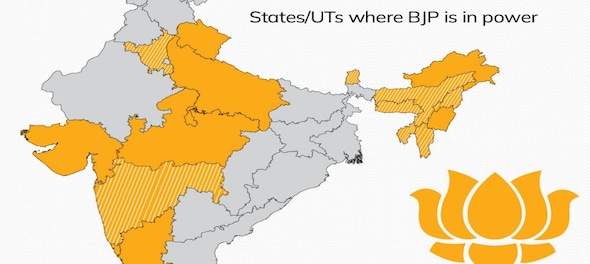
The sobriquet of ‘semifinals’ attached to the just completed elections to the five state assemblies of Chhattisgarh, Madhya Pradesh, Mizoram, Rajasthan and Telangana can be interpreted both as indicative of the contours of political landscape in the country or as an inaccurate characterisation.
The unvarnished truth is that these polls were held six months short of the Lok Sabha elections. This factor alone allows political watchers to deduce from the outcome to determine the way political wind is blowing across different parts of the country.
A strong reflection of this interpretation could be witnessed in the Lok Sabha on Monday morning when members belonging to the Bharatiya Janata Party raised slogans underscoring that PM Narendra Modi government will be back in the saddle for a third time.
The euphoria in the governing coalition is understandable as the BJP swept through all the three Hindi-speaking states of Chhattisgarh, Madhya Pradesh and Rajasthan by trouncing its principal challenger, the Indian National Congress, which won Telangana. Both these national parties were also reduced to become shaky in Mizoram where a strong regional party Zoram Peoples Movement ousted the incumbent Mizo National Front.
In terms of hard calculations, together these three states in North India account for 65 Lok Sabha seats, which will be the second largest pool outside Uttar Pradesh with 80 seats. By sweeping across these states with varying margins in seats and vote share, the BJP re-emphasised its domination in these parts of the country. The contrast stands out since across 519 assembly seats on which elections were held the Congress could garner only 170 seats in a direct contest against the BJP which reaped a harvest of 332 seats.
The stupendous showing by the BJP, even when it had its back to the wall in neighbouring states of Chhattisgarh and Madhya Pradesh underscores that when it comes to contesting elections, the party election machine not only remains in great shape but delivers when it matters the most.
Quick to learn lessons from the reversals in Himachal Pradesh and Karnataka, the BJP re-strategised the campaigns with the PM Modi and Home Minister Amit Shah firmly leading from the front. The formidable duo proved their innate understanding of the electorate and reaching home its message is not lost in the dust and din of high-octane campaigning.
To characterise these assembly polls as ‘semi-finals’ can also be viewed from the standpoint that it will allow political parties to assess what factors worked for the opponents, how efficacious was campaign strategy, how successful were the parties in reaching out various sections of the society with its message and conduct a reality check on the oft-employed ‘anti-incumbency’ phrase. A thorough and clinical introspection would then allow the vanquished to draw up plans that bring back momentum and restores the morale of its countless workers.
Misnomer
While in the light of the above, it would be fine to call the results ‘semi-finals’, a quick peep into some of the past results of these Hindi-speaking states offer a different interpretation.
For instance, in 1998, the BJP lost Madhya Pradesh (MP) and Rajasthan and in 2003 the Congress was ousted in the three states of Chhattisgarh, Madhya Pradesh and Rajasthan. Yet the BJP and the Congress were successful respectively in leading a coalition to form a government at the Centre. The 2009 results too had no bearing and fast-forward to 2018, the Congress emerging victorious in these states did not impact the BJP-led government under PM Modi from being voted back the following year. It will be safe to surmise that the voters are discerning when it comes to choosing a government for a state or the country. The outcomes do not make a case for extrapolating the results to the Lok Sabha
Wither I.N.D.I.A?
There were pundits who wrote a requiem or read the swansong note to the newly-minted opposition platform christened Indian National Democratic Inclusive Alliance (I.N.D.I.A) These are early days and the disparate opposition knows there are parties within its fold which remain formidable in several states, where the BJP or the Congress are not the principal political forces. While the Congress-Samajwadi Party public spat in MP over seat accommodation would be in the backdrop, most parties are aware of inherent strengths and weaknesses of each member of the alliance.
These results are a reality check for the Congress and when parties sit down for hard-nosed negotiations, will reduce the Grand Old Party’s ability to push forth its case strongly for a greater share of seats. The larger objective or adhesive —opposition to the BJP— doesn't remain in place in the face of undiminished popularity of PM Modi and his ability to swing the voters with words of guarantee.
—The author, K V Prasad, is a political analyst and writer. The views expressed are personal
Read his previous articles here
(Edited by : C H Unnikrishnan)
First Published: Dec 4, 2023 9:48 PM IST
Check out our in-depth Market Coverage, Business News & get real-time Stock Market Updates on CNBC-TV18. Also, Watch our channels CNBC-TV18, CNBC Awaaz and CNBC Bajar Live on-the-go!


Supreme Court dismisses plea seeking postponement of CA exams; details here
Apr 29, 2024 2:29 PM
Just 8% women candidates contested first two phases of Lok Sabha polls
Apr 29, 2024 12:00 PM
The sexual assault case against Prajwal Revanna — here's what we know so far
Apr 29, 2024 11:36 AM
Repolling underway at one polling booth in Chamarajanagar LS segment in Karnataka
Apr 29, 2024 10:32 AM

